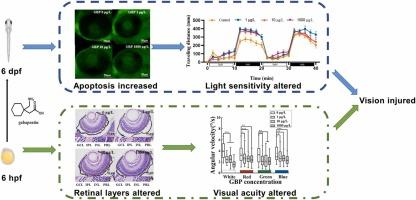加巴喷丁通过视网膜凋亡和甲状腺破坏损害斑马鱼的视觉发育
IF 12.2
1区 环境科学与生态学
Q1 ENGINEERING, ENVIRONMENTAL
引用次数: 0
摘要
加巴喷丁(GBP)是一种广泛用于治疗癫痫发作和神经性疼痛的药物,已成为全球水生环境中的一种污染物,引起了人们对其生态影响的关注。本研究调查了环境相关浓度的 GBP(0、1、10、1000 μg/L)对斑马鱼(Danio rerio)视觉发育的影响。行为分析表明,与对照组相比,所有暴露组的总行程距离(TTD)都显著增加,这表明暴露于 GBP 会增强光敏感性。1 μg/L 和 1000 μg/L 暴露组的 TTD 分别增加了 41% 和 37%(p < 0.05)。细胞凋亡检测显示视网膜细胞的死亡与剂量有关,1000 μg/L 时荧光强度增加了 15%(p < 0.05)。通过光动力反应(OKR)测试测量的视敏度在所有颜色刺激下都显著下降。白光下的角速度从对照组的 4.0 °/s 降至 1000 μg/L 时的 1.6 °/s(p < 0.01),且呈剂量依赖性。视网膜组织病理学显示,当剂量为 1000 μg/L 时,神经节细胞层厚度增加了 17%(p < 0.05),且呈剂量依赖性。甲状腺激素测定显示,T3 和 T4 水平显著降低(p < 0.001),1000 μg/L 时 T3/T4 比率增加 22%。基因表达分析表明,细胞凋亡(casp3a、ifi27)、甲状腺(tshr、dio1)和视网膜发育(atoh7、pax6a)通路出现失调。这些研究结果表明,GBP 通过视网膜凋亡和甲状腺激素失调破坏了斑马鱼的视觉发育,凸显了药物污染物带来的生态风险。暴露于 GBP 会增加光驱动的运动活动,表明视网膜凋亡导致光敏感性增强。通过光动力反应(OKR)测试、视网膜形态学和甲状腺激素(TH)水平来评估视敏度。即使浓度低至 1 微克/升,GBP 暴露也会导致各种颜色的 OKR 显著降低,这可能是由于视网膜厚度的变化与甲状腺激素的干扰有关。这些影响与与细胞凋亡、甲状腺系统和视网膜发育相关的基因表达的改变是一致的。我们的研究结果加深了人们对 GBP 暴露如何损害鱼类视力的理解,并强调了评估水生环境中药物污染物生态风险的必要性。本文章由计算机程序翻译,如有差异,请以英文原文为准。

Gabapentin Impairs Visual Development in Zebrafish via Retinal Apoptosis and Thyroid Disruption
Gabapentin (GBP), a pharmaceutical widely used for seizures and neuropathic pain, has emerged as a contaminant in global aquatic environments, raising concerns about its ecological impact. This study investigated the effects of environmentally relevant concentrations of GBP (0, 1, 10, 1000 μg/L) on visual development in zebrafish (Danio rerio). Behavioral assays showed that GBP exposure enhanced light sensitivity, as indicated by a significant increase in total travel distance (TTD) in all exposure groups compared to controls. The 1 μg/L and 1000 μg/L exposure groups demonstrated a 41% and 37% increase in TTD, respectively (p < 0.05). Apoptosis assays revealed dose-dependent retinal cell death, with fluorescence intensity rising by 15% at 1000 μg/L (p < 0.05). Visual acuity, measured through optokinetic response (OKR) tests, decreased significantly across all color stimuli. Angular velocity under white light decreased from 4.0 °/s in controls to 1.6 °/s at 1000 μg/L (p < 0.01) in a dose-dependent manner. Retinal histopathology showed a 17% increase in ganglion cell layer thickness at 1000 μg/L (p < 0.05) in a dose-dependent manner. Thyroid hormone assays indicated significant reductions in T3 and T4 levels (p < 0.001), with a 22% increase in the T3/T4 ratio at 1000 μg/L. Gene expression analysis revealed dysregulation in apoptosis (casp3a, ifi27), thyroid (tshr, dio1), and retinal development (atoh7, pax6a) pathways. These findings demonstrate that GBP disrupts visual development in zebrafish through retinal apoptosis and thyroid hormone dysregulation, highlighting the ecological risks posed by pharmaceutical pollutants. GBP exposure increased light-driven locomotor activity, indicating heightened light sensitivity due to apoptosis in the retina. Visual acuity was assessed through the optokinetic response (OKR) test, retinal morphology, and thyroid hormone (TH) levels. Even at concentrations as low as 1 µg/L, GBP exposure led to significant reductions in OKR across various colors, likely due to changes in retinal thickness linked to thyroid hormone disruption. These effects were consistent with alterations in gene expression related to apoptosis, the thyroid system, and retinal development. Our findings enhance understanding of how GBP exposure impairs vision in fish and highlight the need to evaluate the ecological risks of pharmaceutical contaminants in aquatic environments.
求助全文
通过发布文献求助,成功后即可免费获取论文全文。
去求助
来源期刊

Journal of Hazardous Materials
工程技术-工程:环境
CiteScore
25.40
自引率
5.90%
发文量
3059
审稿时长
58 days
期刊介绍:
The Journal of Hazardous Materials serves as a global platform for promoting cutting-edge research in the field of Environmental Science and Engineering. Our publication features a wide range of articles, including full-length research papers, review articles, and perspectives, with the aim of enhancing our understanding of the dangers and risks associated with various materials concerning public health and the environment. It is important to note that the term "environmental contaminants" refers specifically to substances that pose hazardous effects through contamination, while excluding those that do not have such impacts on the environment or human health. Moreover, we emphasize the distinction between wastes and hazardous materials in order to provide further clarity on the scope of the journal. We have a keen interest in exploring specific compounds and microbial agents that have adverse effects on the environment.
 求助内容:
求助内容: 应助结果提醒方式:
应助结果提醒方式:


